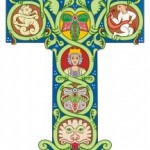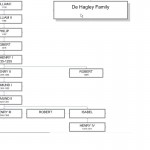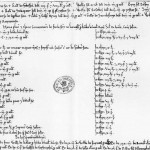The De Hagleys 1130 – 1411
he origins of the de Hagleys are unknown but their reign as lords of the manor of Hagley started some two generations after the Conquest.
The following notes are mainly based on various calendars of pipe rolls, chancery rolls, inquisitions, books of fees, close rolls, patent rolls etc., to be found in Birmingham City Reference Library. The snippets of information have been assembled to give a brief, but interesting, biography of a minor family who occasionally carried out important work, but also got in and out of trouble.
There are ten generations to be considered and, as in most families, Christian names are repeated. Therefore, for the sake of clarity, Roman numbers are used to differentiate between the generations (See family tree below).
The earliest de Hagley is William I7, who is mentioned in 1130 at Stafford court where he is pardoned for non-payment of three shillings Danegeld.
There was another Hagley, which was part of the manor of Rugeley in Staffordshire but the manor was not held by William I. It is possible that the Danegeld was due for land held in Clent which was in Staffordshire through the efforts of a pre-Conquest sheriff and it remained there until 1844.
William II8 appears in 1160 when the manor was assigned to him by Gervase de Pagenal for one knight’s fee. De Pagenal was tenant-in-chief of Dudley at the time and the normal practice for a sub-tenant was to perform guard duties at his lord’s castle for 40 days per year. He would, of course, be suitably armed and clad for these duties at his own expense and would have a small party of “foot soldiers” with him.
It is reasonable to assume that the two Williams were father and son and that William I had died in 1166.
In 1187 Philip de Hagley9 witnessed a charter when another de Paganal granted land to Pickford Priory in Buckinghamshire. It is believed that the first de Paganal to become Lord of Dudley was the son-in-law of William fitz Ansculf, whose father had been sheriff of Buckinghamshire following the Conquest and a century later the family still had connections to that county.
It is interesting to note that in 1212 Hagley10 is listed under the “hundredun quodvocatur dimidius comitatus”, i.e. the hundred that is called half-shire. Previously, Hagley had been in Clent hundred which together with Cresslau and part of Fishborough, then became half-shire, i.e. the northern third of the county.
By around 1216 Robert11 was lord of the manor and was getting 20 shillings a year for a mill from Hugh Drugel, who held the manor of Churchill and the advowson of the church for 6s. 8d.* a year. It is believed that the mill in Mill Lane, Churchill, is on the site of the one that was around in 1216 and until 1933 was actually in Hagley parish. The stream to the west of the mill being the manorial and subsequent parish boundary, someone must have been astute in building the mill in that position, or else dumb in accepting the stream as a boundary; it really depends which side of the boundary you reside as to the point of view you adopt.
Sir Henry I12 held the manor in 1235/6 and by 1255 we learn from the Calendar of Pipe Rolls that he is granted13 “exemption for life of appointment against his will to being put on assizes, juries or being made sheriff; coroner; escheator; forrester; verderer; regarder or other baliff of the King against his will”.
One gets the feeling that Sir Henry had had more than enough of public office and had successfully applied to retire quietly.
By implication, invitations from the King to carry out certain duties were not an optional extra and King Henry III must have found his namesake a reliable, local government officer and worthy of knighthood.
Sir Henry’s son, Henry II, chose his wife carefully. She was Lecia, the daughter and heir of Henry de Linguire, who held one of the four manors based on Adderbury14, which lies south of Banbury in Oxfordshire, some 45 miles to the south east of Hagley. This increase in the de Hagley fortunes probably made possible the rebuilding of the church at Hagley in the decorated style of the late 13th century. Locally, Henry II held both Hagley and Lutley for 1¼ knight’s fee and also held “Lortil”15 in Staffordshire from on Roger de Somery. The location of Lortil is not known to the writer.
Edmund I was the next lord of the manor, who also married well. Isabella was the widow of Philip Burnell (d.1294), who was the nephew of Bishop Burnell of Bath and Wells and also Chancellor of England in the reign of Edward I. Acton Burnell castle in Shropshire was the work of the Bishop. Philip had held land in Norfolk16 and Dudley, so, by marrying Isabella Burnell in c1305, Edmund I would have increased the de Hagley family influence and fortunes.
An interesting comment on justice at the time is recorded in 1303. William17, son of Nicholas of Hagley (who may or may not have had any direct connection with the main line of the de Hagley family) was pardoned at Dumfermline by consideration of his service in Scotland, along with 20 others, for the death of Richard, son of John of Saltleye. It sounds like an off duty brawl that went too far and extenuating circumstances were taken into account!
Edmund II is described as the son of Isabella; was he the stepson of Edmund I? In February 131818, Edmund with others, damaged the property of John Peche. Not content with that, they returned, plus Isabella, in April 1318 and burned John Peche’s house at Stotteswell, north west of Banbury. What caused the row is unknown but the miscreants were fined one mark (67p). So much for being well connected.
Shortly after this episode in 1322, the last of the de Somery males died at Dudley and the Dudley estate was split between his two sisters. One had married a Sutton and they retained Dudley Castle. The other was married to John de Botetort, and they were based at Weoley Castle, seven miles east of Hagley. The Worcestershire manors of Frankley, Warley; Belne; Pedmore; Swinford; Hagley and Cradley were assigned to Botetfort.
The behaviour of the family did not improve with time as the following events illustrate.
In October 134619, William de Dunclent (Parson of Hagley), Robert and Henry de Hagley, plus twenty-nine others “broke the close and houses of the rectory occupied by Thomas de Baddeley, parson of Treddington and carried away goods and attacked the servants”.
In April 134720, the same gang, plus Brother Richard de Dunclent, with Master Thomas and Walter de Dunclent and Edmund II (Lord of Hagley Manor) “attacked the servants of John de Bello Campo at Sibford, while he was abroad with the King”. Presumably this was King Edward III at the siege of Calais.
Their cases came up in August 134821 and Robert de Hagley, with others, was pardoned on payment of a £22 fine. The whole sorry episode revolved around the rights of Thomas de Baddeley (King’s nominee) and Thomas de Dunclent (Pope’s nominee) to be the parson of Treddington.
Both Treddington and Sibford are some ten miles to the west of Adderbury, but it looks as though the raiding parties were friends and neighbours from Hagley and Dunclent.
1349 saw the Black Death sweeping England and it is reasonable to assume that Hagley had its share of the plague. William Humon22 de Dudley was appointed as parson on 22nd April 1349 and he was followed by William de Belne on 2nd July. On the 10th August, Robert23, son of Edmund II, was granting land which he held from his father, to five sub-tenants. The land lay between Hagley wood and Lutley. Mid-August is an odd time to be dealing in agricultural land, so it can be assumed that Robert no longer had the men to work the land or gather any crops. Things must have got worse for, in 1351, Edmund II24 was conveying to Sir John Botetort, the manor of Hagley and the advowson of the church for 100 silver marks (£67).
After the transfer of Hagley, it appears that Edmund II, Henry III (d.1365) and Robert, left Hagley and lived at Adderbury. Neither Henry III nor Robert had male heirs so it was left to their nephew Henry IV, son of their sister Isabella, to make a bid for the Hagley manor.
This was successfully concluded in 137325 when Henry IV was 21. The annual rent was fixed at 17 marks (£11), which when compared with the 1351 “sale price”, would appear to be inflationary.
Henry’s fortunes seem to have been rather mixed as the following extracts from various calendars demonstrate.
In May 139226, protection granted in 1391 was revoked, because he tarried on his own affairs instead of being on the King’s service. This could not have been regarded as too serious because a month later he was commissioned with four others to arrest Nicholas Pole27, Chaplain. 139528 saw his appointment as escheator for the county. This position involved supervision of all estates where the occupier had died, nominally to ensure that the King secured the equivalent of inheritance tax, but it is possible that “arrangements” may have been made to cover the escheator’s expenses. Two years later he was sheriff but at the end of 139729 he was in trouble. He is pardoned, after his goods and chattels are forfeited to the King for various urgent needs (this is the time of despotic rule by Richard II).
By 1400 Henry IV was King and Henry IV de Hagley was back in the escheator’s job.
Owain Glyn Dwr was causing trouble in Wales and the Marches between 1400 and 1409 and during this time Henry was included in a number of commissions of array30 to pick out suitable men to fight Glyn Dwr. At the same time (1404-7) he took part in six commissions of peace at Westminster and Worcester, without achieving positive results.
In 141131 Henry sold Hagley to Thomas Walwyn and retired to Adderbury with his wife, Alice. In 142832 she was described as “super uxor” (lately wife of) Henry and she died in 1433.
The only other name of interest is Thomas de Hagley33, as heir of Henry II, obtained a license to transfer Hagley manor (which is the name by which the de Hagley’s manor at Adderbury was known) to Humphrey Hay and John Gail. Sometime between 1435 and 1460, the estate at Adderbury was sold to William Brome (Brown).
A Thomas34 shows up again in 1450 as a yeoman at Southwark, who, with all others of that borough, are granted a general pardon following Jack Cade’s rebellion. He may or may not have been connected to Adderbury or Hagley, but had the same skills of getting in and out of trouble as did the rest of the family.
7Pipe Rolls 31 Hen I
8History of Worcestershire – Nash – vol. 1 p.487
9History of Worcestershire – Nash – vol. 1 p.487
10Book of fees p.140
11Lyttelton charters No. 10
12Book of fees p.527
13Cal. of pipe rolls 39 Ed I
14Feudal aids vol. 4
15Feudal aids vol.5
16Feudal aids vol.6
17Cal.of pipe rolls 31 Ed. I
18Cal.of pipe rolls 11 Ed. II
19Cal.of pipe rolls 19 Ed. III
20Cal.of pipe rolls 20 Ed. III
21Cal.of pipe rolls 21 Ed. III
22Nash Vol 1 50
23Lyttelton charter No. 142
24Lyttelton charter No. 147
25Descriptive catalogue of ancient deeds vol. II 46 Ed. III
26Cal.of pipe rolls 15 Rich. II
27Cal.of pipe rolls 15 Rich. II
28Inquisitions misc. 1387-93
29Cal.of pipe rolls 1396-99 Rich. II
30Cal.of pipe rolls 1399-1401 Hen IV
31Nash vol. 1 p489
32Feudal aids vol. 4
33Cal.of pipe rolls 1429-36 Hen. VI
34Cal.of pipe rolls 1446-52 Hen. VI
*6s. 8d. is pre-decimalisation(1971) notation for 6 shillings and 8 pence, where 12 pence = 1 shilling = 5p (new pence)


